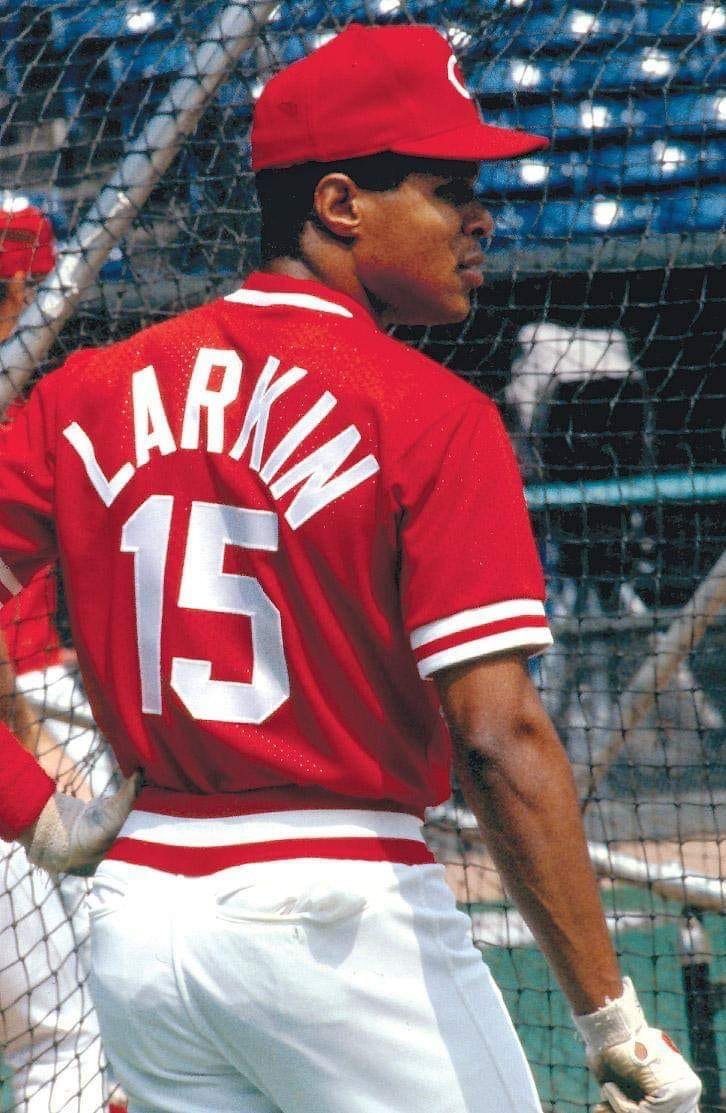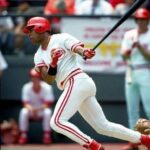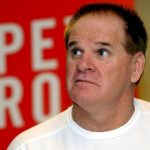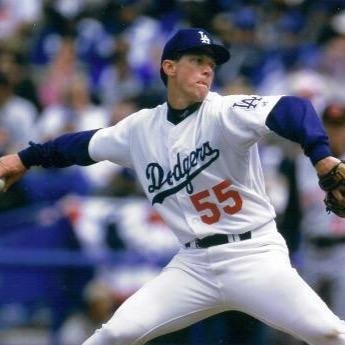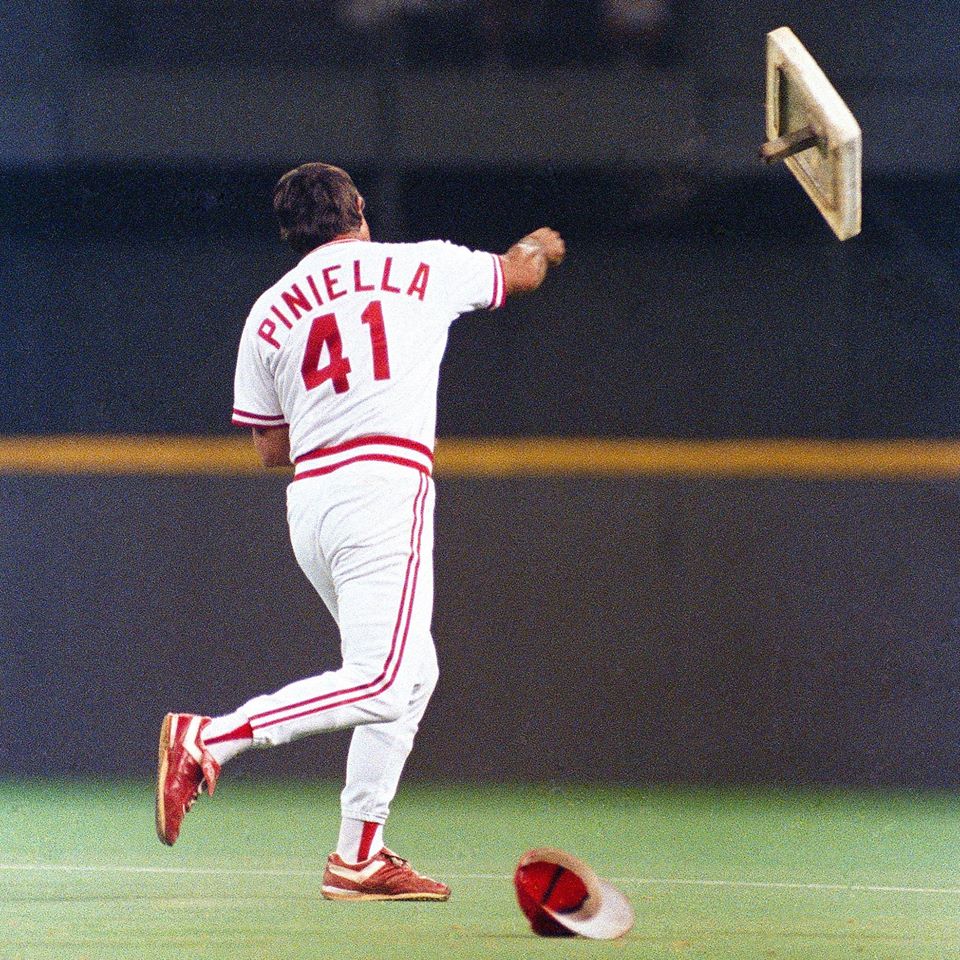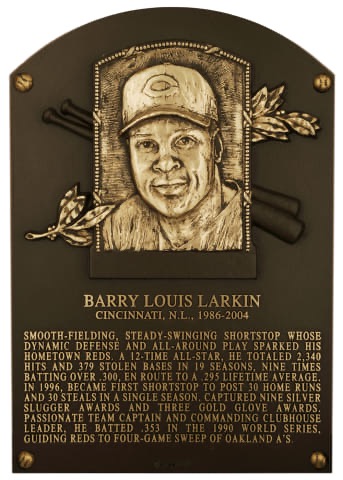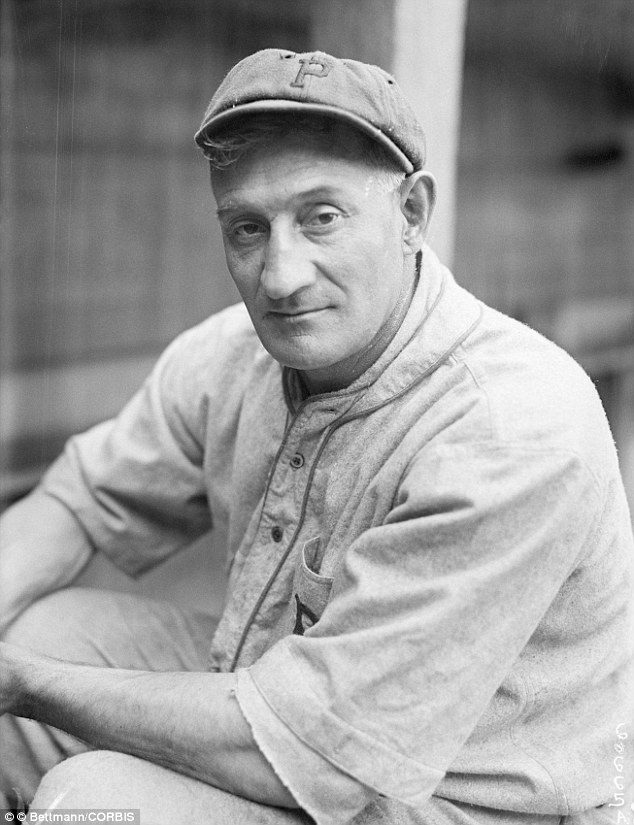Barry Larkin Stats & Facts
VINTAGE BASEBALL MEMORABILIA
Barry Larkin Essentials
Position: Shortstop
Bats: Right • Throws: Right
6-0, 185lb (183cm, 83kg)
Born: April 28, 1964 in Cincinnati, OH
High School: Archbishop Moeller HS (Cincinnati, OH)
School: University of Michigan (Ann Arbor, MI)
Debut: August 13, 1986 (15,229th in major league history)
vs. SFG 1 AB, 0 H, 0 HR, 1 RBI, 0 SB
Last Game: October 3, 2004
vs. PIT 1 AB, 0 H, 0 HR, 0 RBI, 0 SB
Hall of Fame: Inducted as Player in 2012. (Voted by BBWAA on 495/573 ballots)
View Barry Larkin’s Page at the Baseball Hall of Fame (plaque, photos, videos).
Agents: Eric Goldschmidt
Full Name: Barry Louis Larkin
Twitter: @BarryLarkin
View Player Info from the B-R Bullpen
View Player Bio from the SABR BioProject
Nine Players Who Debuted in 1986
Rafael Palmeiro
Barry Bonds
Fred McGriff
Barry Larkin
Bobby Bonilla
Ruben Sierra
Mark McGwire
Greg Maddux
David Cone
The Barry Larkin Teammate Team
C: Benito Santiago
1B: Pete Rose
2B: Bret Boone
3B: Chris Sabo
SS: Davey Concepcion
LF: Eric Davis
CF: Ken Griffey Jr.
RF: Dave Parker
SP: Jose Rijo
SP: Mario Soto
SP: David Wells
SP: Tom Browning
SP: Danny Jackson
RP: Norm Charlton
RP: Rob Dibble
M: Tony Perez
Notable Events and Chronology for Barry Larkin Career
Biography
Barry Larkin had the misfortune of spending the majority of his career playing in the shadow of other great shortstops. Ozzie Smith was considered to be the National League’s premier player at the position during Larkin’s first several years in the league, while Cal Ripken Jr. held that same distinction in the American League. Meanwhile, Alex Rodriguez, Derek Jeter, and Nomar Garciaparra took turns supplanting each other as baseball’s top shortstop during the second half of Larkin’s career. Still, Larkin was the National League’s best all-around player at the position for the better part of his 19-year major league career, surpassing Smith as the senior circuit’s preeminent shortstop at the beginning of the 1990s. In fact, even though Smith continued to receive more publicity than Larkin the next several years, the Cincinnati shortstop was clearly the better player. During the decade of the ’90s, Larkin batted over .300 seven times, hit more than 20 homers twice, scored more than 100 runs twice, stole more than 30 bases four times, and developed into one of the finest defensive shortstops in baseball.
Biography:
A classic case of “hometown boy made good,” Barry Louis Larkin spent his entire career playing for the team he rooted for as a youngster. Born in Cincinnati, Ohio on April 28, 1964, Larkin was a huge fan of Dave Concepcion and the rest of Cincinnati’s Big Red Machine while growing up during the 1970s. In fact, Larkin decided at the age of five that he would someday replace his childhood idol as the team’s starting shortstop.
After initially being drafted in the second round by the Reds in 1982, the three-sport star at Queens City’s Moeller High School elected instead to attend the University of Michigan. Larkin spent the next three years honing his baseball skills in college, batting .311 as the starting shortstop for the 1984 U.S. Olympic Team, before being selected again by the Reds, this time with the fourth overall pick in the 1985 free-agent draft. The talented Larkin spent less than two full years in the minors before he made his major league debut with the Reds on August 13, 1986. He started 34 of the 41 games in which he appeared the remainder of the season, batting .283, scoring 27 runs, and going a perfect 8-for-8 in stolen base attempts. Larkin slumped badly during the early stages of the 1987 campaign as he battled fellow prospect Kurt Stillwell for the team’s starting shortstop job. However, he eventually righted himself, finishing the year with a respectable .244 batting average, 12 home runs, and 21 stolen bases, thereby prompting the Reds to trade Stilwell to Kansas City in the off-season.
Early Years in Cincinnati:
Firmly entrenched as Cincinnati’s starting shortstop, Larkin became a key contributor to the team’s offense in his first full season. He ended the 1988 campaign with a .296 batting average, 91 runs scored, and 40 stolen bases, while also leading all major leaguers with only 24 strikeouts in 588 official at-bats. Larkin’s solid performance earned him the first of four consecutive trips to the All-Star Game.
The only flaw in Larkin’s game at the time was his defense. Although he possessed outstanding range in the field, the young shortstop occasionally performed erratically with the glove, leading all N.L. players at his position with 29 errors. Larkin worked extremely hard on his defense and, after missing almost half of the following season with an injury, he returned in 1990 to commit only 17 errors in his 154 games at shortstop. Larkin also continued to develop as a hitter, batting .301, and establishing new career highs with 67 runs batted in and 185 hits.
Development into Team Leader and National League’s Best Shortstop:
However, it was as a team leader that Larkin perhaps showed the most growth. With the Reds struggling to close out the National League West title in September of 1990, Larkin called a team meeting, during which he criticized his teammates for coasting down the stretch. His teammates responded by quickly closing out the division, before eventually going on to defeat the Pirates in the NLCS and the heavily-favored Oakland A’s in the World Series. Larkin batted .353 during his team’s four-game sweep of Oakland in the Fall Classic.
Larkin clearly established himself as the National League’s finest all-around shortstop over the next several years, posting batting averages of .302, .304, and .315 in 1991, 1992, and 1993, respectively, hitting as many as 20 home runs in the first of those seasons, and committing a total of just 42 errors over that stretch of time. After another solid 1994 campaign in which he earned the first of three consecutive Gold Gloves, Larkin was named National League MVP in 1995 for leading the Reds to the Central Division title. The shortstop’s offensive numbers weren’t particularly overwhelming – he batted .319, scored 98 runs, and stole a career-high 51 bases, but hit only 15 home runs and knocked in just 66 runs. But Larkin committed only 11 errors in the field, and he was Cincinnati’s unquestioned leader. The Reds subsequently defeated the Dodgers in the NLDS, before losing to the eventual champion Atlanta Braves in the NLCS. Larkin batted .385 against the Dodgers, and then posted a mark of .389 against the Braves.
Larkin had his greatest statistical season in 1996, batting .298, stealing 36 bases, and establishing career highs with 33 home runs, 89 runs batted in, and 117 runs scored. By surpassing 30 homers and 30 stolen bases in the same year, Larkin became the first major league shortstop to do so. Ozzie Smith was so impressed with Larkin’s performance that he approached his rival at the All-Star Game, presented him with an autographed bat, and said, “The torch is now yours.”
After being named captain of the Reds prior to the start of the 1997 season, Larkin remained the National League’s top shortstop until injuries began to significantly reduce his playing time in 2000. He continued to perform effectively, though, whenever his name was written on the lineup card, posting a batting average of .289 in 2004, his final year with the team. Larkin retired at the end of the season with 198 home runs, 960 runs batted in, 1,329 runs scored, 2,340 hits, a .295 batting average, and 379 stolen bases in 456 attempts, for an outstanding 83 percent success rate. He batted over .300 nine times, finished in double-digits in home runs nine times, surpassed 30 stolen bases five times, and scored more than 100 runs twice. In addition to his three Gold Gloves, Larkin finished in the top ten in the league MVP voting twice and was selected to 12 All-Star teams.
Ranked number six by baseball historian Bill James on his list of all-time great shortstops, Larkin appears to have an excellent chance of eventually being elected to Cooperstown, since he received an extremely representative 51.6% of the vote the first time his name appeared on the ballot in 2010.
@ET-DC@eyJkeW5hbWljIjp0cnVlLCJjb250ZW50IjoicG9zdF90YWdzIiwic2V0dGluZ3MiOnsiYmVmb3JlIjoiTGVhcm4gTW9yZSBhYm91dCB0aGUgdGVhbXMsIHBsYXllcnMsIGJhbGwgcGFya3MgYW5kIGV2ZW50cyB0aGF0IGhhcHBlbmVkIG9uIHRoaXMgZGF0ZSBpbiBoaXN0b3J5IC0gLSAtIC0gLSAtIC0gIiwiYWZ0ZXIiOiIiLCJsaW5rX3RvX3Rlcm1fcGFnZSI6Im9uIiwic2VwYXJhdG9yIjoiIHwgIiwiY2F0ZWdvcnlfdHlwZSI6InBvc3RfdGFnIn19@
Family Tree
Larkin’s brother, Stephen, an infielder in the Reds’ organization, was called up to Cincinnati to start the last game of the 1998 season at first base. With Bret and Aaron Boone at second and third, respectively, the Reds lineup was the first in baseball history to feature two sets of siblings.
Linked: Dave Concepcion, Ozzie Smith, Maury Wills
Best Season, 1996
Coming off his 1995 season, Larkin cranked it up a notch, hitting 33 homers, 13 more than any season in the past. He hit .298 (just missing his seventh .300 season), and set personal bests in runs (117) and RBI (89). He played 152 games, showing what he was capable of when he remained healthy. Realizing a new era of shortstop play had emerged, at the ’96 All-Star game, Ozzie Smith presented Larkin with an autographed bat and proclaimed “the torch is now yours.”
Awards and Honors
1994 NL Gold Glove
1995 NL Gold Glove
1995 NL MVP
1996 NL Gold Glove
Post-Season Appearances
1990 National League Championship Series
1990 World Series
1995 National League Championship Series
1995 National League Divisional Series
Feats: Larkin was the first shortstop to steal 30 bases (36) and slug 30 homers (33) in a single season, in 1996… On June 27-28, 1991, Larkin became the first major league shortstop to hit five homers in two games.
Hitting Streaks
23 games (1988)
23 games (1988)
21 games (1988)
21 games (1988)
19 games (1994)
19 games (1991)
19 games (1994)
19 games (1991)
Let’s Go Blue!
Larkin played for the University of Michigan in the 1980s, earning All-American honors and Big Ten Conference Player of the Year twice. Others to play for the Maize and Blue during the 1980s were Chris Sabo (later a teammate of Larkin’s on the Reds), Jim Abbott and Jim Paciorek.
The Olympian
In 1984, Larkin batted .311 as the starting shortstop for the talented U.S. Olympic team which included future big league stars Will Clark and Mark McGwire.
All-Star Selections
1988 NL
1989 NL
1990 NL
1991 NL
1993 NL
1994 NL
1995 NL
1996 NL
1997 NL
1999 NL
2000 NL
2004 NL
Replaced
At the end of 1986, Larkin batted .283, starting 34 of his 41 games down the stretch, and began the 1987 season determined to beat out fellow prospect Kurt Stillwell as Dave Concepcion’s successor. Larkin endured a sophomore slump during a first half which saw him hit just .209, but he rebounded late in the year to finish at a respectable .244 with 12 home runs and 21 stolen bases. In November, Stillwell was dealt to Kansas City for pitcher Danny Jackson.
Replaced By
Felipe Lopez
Best Strength as a Player
Athleticism
Largest Weakness as a Player
None, other than his inability to avoid injury. But he still collected more than 2,300 hits, nearly 200 home runs, and swiped 379 bases.
Other Resources & Links

